Exercises (2273)
Jump onto an object ► jump
Power
Individual work

Jump with both legs onto the object on the ground (e.g. tyre) and back down to the starting position.
Attention:
Keep your upper body upright and cushion your landing.
Lighten:
Select a lower element; lower cadence.
Harden:
Higher cadence; additional weight (on the feet); standing on the object, jump back up to the starting position.
1 tyre (10DM)
1 tyre (DURO)/helmet ► Make the exercise easier
2 weight cuffs/1 weight waistcoat ► Make the exercise more difficult (additional weight)
Step onto an object (left) ► step up
Power
Individual work



Stand upright in front of the plyo box (the vaulting box - 1 intermediate element plus top), step onto the object first with the left leg, then with the other leg and back down to the starting position (stair climbing). A weight is held in both hands or in the arms (dumbbells, kettlebells, medicine ball). The start/starting leg remains identical for each exercise.
Attention:
Keep your upper body upright.
Lighten:
Select a lower element; lower cadence.
Harden:
Select a higher element; higher cadence; more weight/greater load; additional weight (on the feet).
1 plyo box/swivel box
2 dumbbells/kettlebells/1 medicine ball
2 weight cuffs/1 weight waistcoat ► make the exercise more difficult (additional weight)
Step onto an object (left) ► step up
Power
Individual work




Stand upright in front of the plyo box (the vaulting box - 1 intermediate element plus top), first step onto the object with the left leg, then with the other leg and back down to the starting position (stair climbing). The start/starting leg remains the same for each exercise.
Attention:
Keep your upper body upright.
Lighten:
Select a lower element; lower cadence.
Harden:
Choose a higher element; higher cadence; hold the weight in both hands; additional weight (on the feet).
Variation:
Alternate with the left/right foot first (more demanding in terms of coordination).
1 plyo box/swing box
2 dumbbells/kettlebells/1 medicine ball ► make the exercise more difficult (additional weight)
2 weight cuffs/1 weight waistcoat ► make the exercise more difficult (additional weight)
Step onto an object (left) ► step up
Power
Individual work
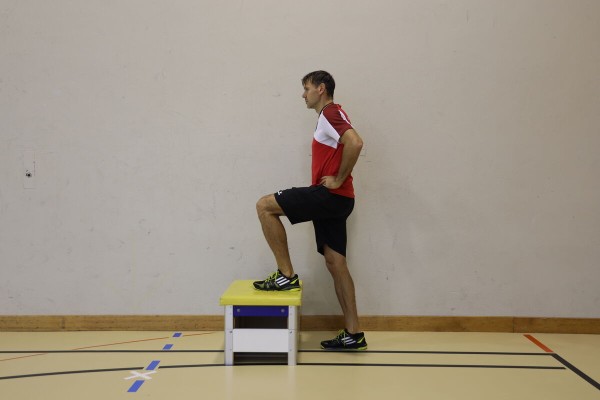

Stand upright in front of the plyo box (the vaulting box - 1 intermediate element plus top), with one leg stretched out on the floor and the other (left) leg bent on the raised surface. Extend the bent leg and at the same time move the leg placed on the floor onto the base in order to stand on the box/swinging box. Then move both legs back to the starting position (right leg back on the floor, left leg remains on the raised surface).
Attention:
Keep your upper body upright, distribute your weight over your entire foot, push your knees outwards (do not tilt inwards).
Lighten:
Select a lower element.
Harden:
Select a higher element; additional weight (on the back, in the hands or on the foot).
1 plyo box/swinging box
2 dumbbells/kettlebells/1 medicine ball/weight cuff/weight waistcoat ► make the exercise more difficult (additional weight)
Step onto an object (left) ► step up
Power
Individual work

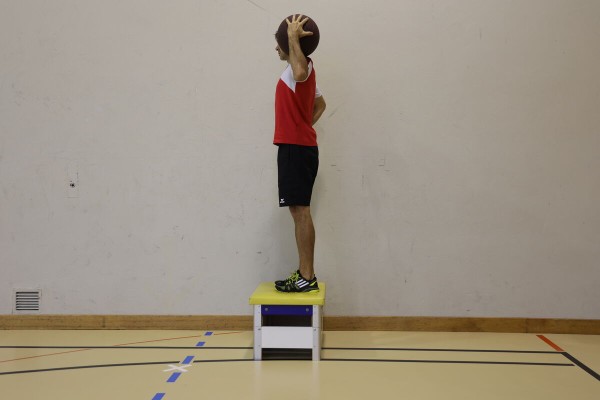
Stand upright in front of the plyo box (the vaulting box - 1 intermediate element plus top), with one leg stretched out on the floor and the other (left) leg bent on the raised surface. A medicine ball (or another weight such as a dumbbell or kettlebell) is held on the shoulder with a bent arm on the side where the leg is placed on the raised surface. Extend the bent leg and at the same time move the leg placed on the floor onto the base to get to a standing position on the box/swinging box. Then move both legs back to the starting position (right leg back on the floor, left leg remains on the raised surface).
Attention:
Keep your upper body upright, distribute your weight over your entire foot, push your knees outwards (do not tilt inwards).
Lighten:
Select a lower element; do not hold any weight on the shoulder.
Harden:
Select a higher element; more weight; additional weight on the foot.
Variation:
Hold a weight (dumbbell or kettlebell) in both hands with hanging arms.
1 plyo box/swinging box
1 medicine ball/dumbbell/kettlebell
1 weight sleeve/weight waistcoat ► make the exercise more difficult (additional weight)
1 additional dumbbell/kettlebell ► variation of the exercise
Step onto an object (right) ► step up
Power
Individual work



Stand upright in front of the plyo box (the vaulting box - 1 intermediate element plus top), step onto the object first with the right leg, then with the other leg and back down to the starting position (stair climbing). A weight is held in both hands or in the arms (dumbbells, kettlebells, medicine ball). The start/starting leg remains identical for each exercise.
Attention:
Keep your upper body upright.
Lighten:
Select a lower element; lower cadence.
Harden:
Select a higher element; higher cadence; more weight/greater load; additional weight (on the feet).
1 plyo box/swivel box
2 dumbbells/kettlebells/1 medicine ball
2 weight cuffs/1 weight waistcoat ► make the exercise more difficult (additional weight)
Step onto an object (right) ► step up
Power
Individual work




Stand upright in front of the plyo box (the vaulting box - 1 intermediate element plus top), first step onto the object with the right leg, then with the other leg and back down to the starting position (stair climbing). The start/starting leg remains the same for each exercise.
Attention:
Keep your upper body upright.
Lighten:
Select a lower element; lower cadence.
Harden:
Select a higher element; higher cadence; hold the weight in both hands; additional weight (on the feet).
1 plyo box/swing box
2 dumbbells/kettlebells/1 medicine ball ► make the exercise more difficult (additional weight)
2 weight cuffs/1 weight waistcoat ► make the exercise more difficult (additional weight)
Step onto an object (right) ► step up
Power
Individual work
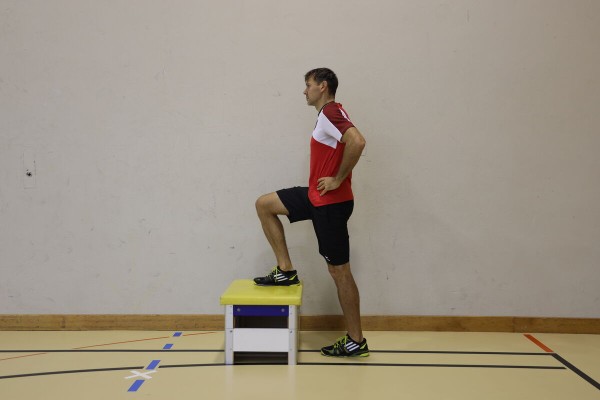

Stand upright in front of the plyo box (the vaulting box - 1 intermediate element plus top), with one leg stretched out on the floor and the other (right) leg bent on the raised surface. Extend the bent leg and at the same time move the leg placed on the floor onto the base in order to stand on the box/swinging box. Then move both legs back to the starting position (left leg back on the floor, right leg remains on the raised surface).
Attention:
Keep your upper body upright, distribute your weight over your entire foot, push your knees outwards (do not tilt inwards).
Lighten:
Select a lower element.
Harden:
Select a higher element; additional weight (on the back, in the hands or on the foot).
1 plyo box/swinging box
2 dumbbells/kettlebells/1 medicine ball/weight cuff/weight waistcoat ► make the exercise more difficult (additional weight)
Step onto an object (right) ► step up
Power
Individual work
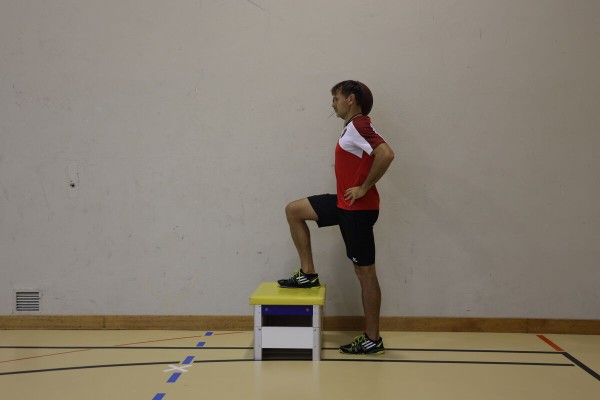
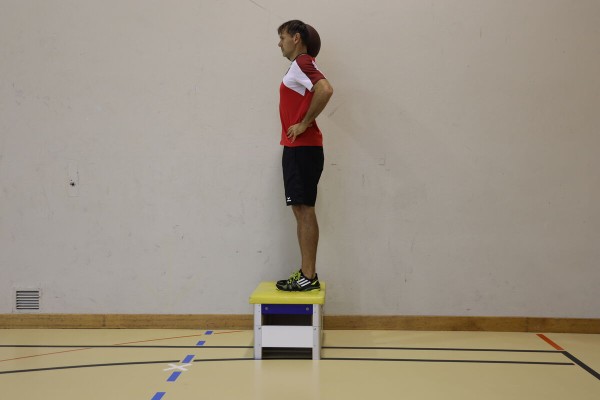
Stand upright in front of the plyo box (the vaulting box - 1 intermediate element plus top), with one leg stretched out on the floor and the other (right) leg bent on the raised surface. A medicine ball (or another weight such as a dumbbell or kettlebell) is held on the shoulder with a bent arm on the side where the leg is placed on the raised surface. Extend the bent leg and at the same time move the leg placed on the floor onto the base to get to a standing position on the box/swinging box. Then move both legs back to the starting position (left leg back on the floor, right leg remains on the raised surface).
Attention:
Keep your upper body upright, distribute your weight over your entire foot, push your knees outwards (do not tilt inwards).
Lighten:
Select a lower element; do not hold any weight on the shoulder.
Harden:
Select a higher element; more weight; additional weight on the foot.
Variation:
Hold a weight (dumbbell or kettlebell) in both hands with hanging arms.
1 plyo box/swinging box
1 medicine ball/dumbbell/kettlebell
1 weight sleeve/weight waistcoat ► make the exercise more difficult (additional weight)
1 additional dumbbell/kettlebell ► variation of the exercise
Step up onto an object ► step up
Power
Individual work


Stand upright with your feet shoulder-width apart in front of the object, step onto the object lying on the floor (e.g. tyre) first with one leg and then with the other and then back down to the starting position (climbing stairs). Switch the starting position/leg too.
Attention:
Keep your upper body upright.
Lighten:
Select a lower element; lower cadence.
Harden:
Higher cadence; additional weight (on the feet); standing on the object, two-legged jump upwards back to the starting position.
Variant:
Alternate with the left/right foot first (more demanding in terms of coordination).
1 tyre (10DM)
1 tyre (DURO)/helmet ► make the exercise easier (position)
2 weight cuffs/1 weight waistcoat ► make the exercise more difficult (additional weight)
Step up onto an object ► step up
Power
Individual work



Stand upright with your feet shoulder-width apart in front of the long bench, step onto the long bench first with one leg and then the other and then back down to the starting position (stair climbing). Alternate start/leg as well.
Attention:
Keep your upper body upright.
Lighten:
Select a lower element (e.g. vaulting box top); lower cadence.
Harden:
Choose a higher element; higher cadence; additional weight (on the feet); two-legged jump into the air after standing on the long bench.
Variant:
Alternate with the left/right foot first (more demanding in terms of coordination).
1 long bench
1 vaulting box top section ► easier exercise (position)
2 vaulting box elements (incl. top section) ► more difficult exercise (position)
2 weight cuffs/1 weight waistcoat ► more difficult exercise (additional weight)
Step onto an object alternately ► step up
Power
Individual work


Stand upright in front of the (flat) bench, first with one leg, then with the other, climb onto the bench and back down to the starting position (stair climbing). Change starting position/leg after each exercise or after a few repetitions.
Starting position:
- From an upright, shoulder-width stance, position one foot on the bench
- Hold the weight in your hands on one or both sides or place it on your shoulders
- Tense your abdominal and gluteal muscles
Finishing position:
- Stand upright on the bench
- Keep your back straight
Attention:
Keep your upper body upright, distribute your weight over your entire foot, push your knees outwards (do not tilt inwards).
Variant:
Alternate with the left/right foot first (more demanding in terms of coordination).
1-2 dumbbell(s)/kettlebell(s) or 1 barbell
Step onto an object alternately ► step up
Power
Individual work
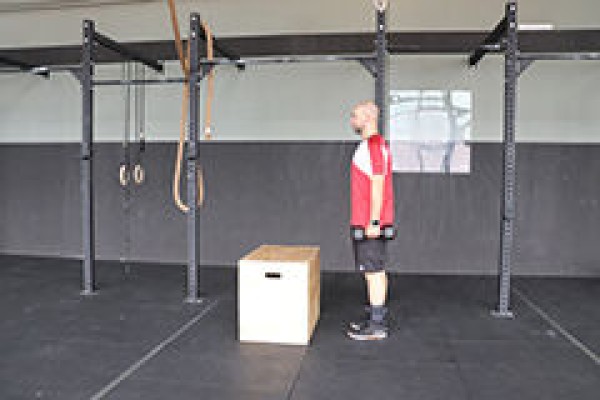





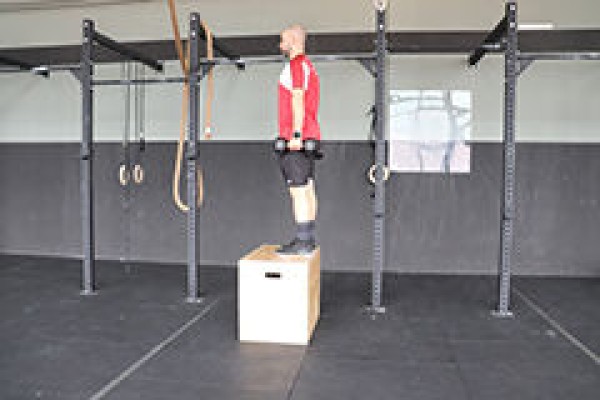


Stand upright in front of the plyo box (the vaulting box - 1 intermediate element plus top), step onto the object first with one leg, then with the other and back down to the starting position (stair climbing). A weight is held in both hands or in the arms (dumbbells, kettlebells, medicine ball). Change the starting position/leg after each exercise.
Attention:
Keep your upper body upright.
Lighten:
Select a lower element; lower cadence.
Harden:
Select a higher element; higher cadence; more weight/greater load; additional weight (on the feet).
1 plyo box/swivel box
2 dumbbells/kettlebells/1 medicine ball
2 weight cuffs/1 weight waistcoat ► make the exercise more difficult (additional weight)
Step onto an object alternately ► step up
Power
Individual work


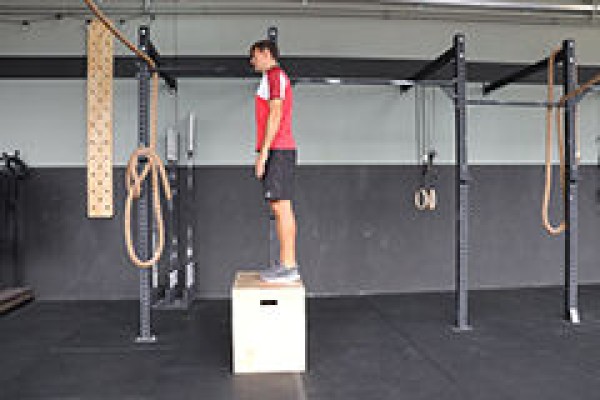


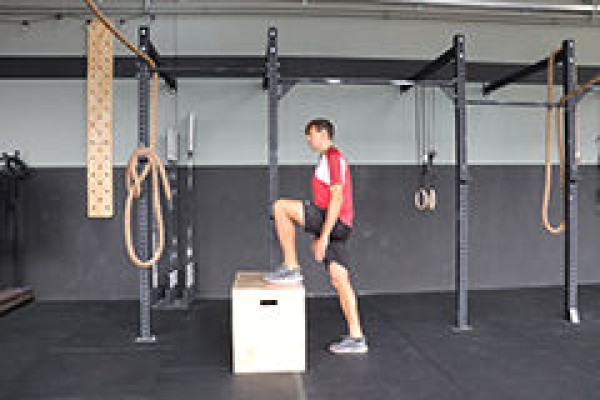



Stand upright in front of the plyo box (the vaulting box - 1 intermediate element plus top), first step onto the object with one leg, then with the other leg and back down to the starting position (stair climbing). Change the starting position/leg after each exercise.
Attention:
Keep the upper body upright.
Lighten:
Select a lower element; lower cadence.
Harden:
Select a higher element; higher cadence; hold the weight in both hands; additional weight (on the feet).
1 plyo box/swing box
2 dumbbells/kettlebells/1 medicine ball ► make the exercise more difficult (additional weight)
2 weight cuffs/1 weight waistcoat ► make the exercise more difficult (additional weight)
Climb onto an object in push-up position ► stair walking push up position
Power
Individual work



Push-up position, hands placed on an object (e.g. combat rucksack or tyre), step down from the object (move hands to the floor one after the other) and return to the starting position.
Attention:
No hollow back, tense torso, elbows bent approx. 45 degrees from the upper body ("A" shape with the arms), shoulders are fixed and pressed down towards the hips.
Lighten:
Support in place (possibly raise arms slightly alternately).
Harden:
Higher object; additional weight (on the back); unstable support for the legs.
1 combat rucksack/tyre (PUCH)
1 tyre (10DM) ► make the exercise more difficult (position)
1 weight vest/weight disc/sandbag/(additional) combat rucksack ► make the exercise more difficult (additional weight)
1 ball/1-2 balance cushions/1 balance board ► make the exercise more difficult (unstable base)
Climb onto an object in push-up position ► stair walking push up position
Power
Individual work



Push-up position, hands placed on the top of the vaulting box; step down from the box (move your hands to the floor one after the other) and return to the starting position.
Attention:
No hollow back, tense torso, elbows bent at an angle of approx. 45 degrees from the body ("A" shape with the arms), shoulders are fixed and pressed down towards the hips.
Lighten:
Support yourself in place (if necessary, lift your arms slightly alternately).
Harden:
Higher object (e.g. additional vaulting box element or long bench); additional weight (on your back); unstable support for your legs.
1 vaulting box top
1 additional vaulting box element or 1 long bench ► make the exercise more difficult (position)
1 weight vest/weight disc/sandbag ► make the exercise more difficult (additional weight)
1 ball/balance cushion/balance board ► make the exercise more difficult (unstable base)
Step onto an object and one-legged jump (left) ► step up & hop
Power
Individual work
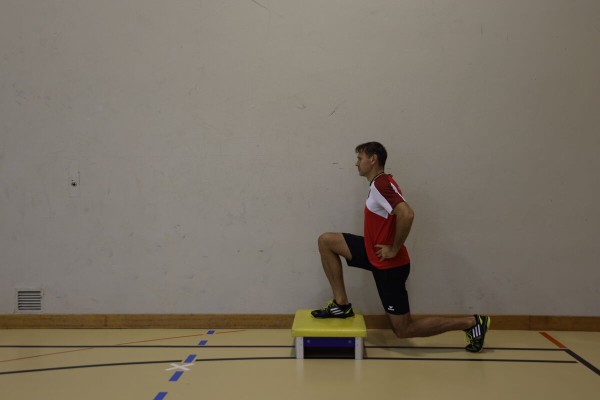

Stand in a lunge in front of the plyo box (the vaulting box - 1 intermediate element plus top), with the back (left) leg resting on the tip of the toe. Move the back leg onto the raised surface (leg bent at approximately a right angle), extend the free leg in a fluid movement and at the same time perform a small jump into the air. Land back on the plyo box/swinging box using only the leg with which the one-legged jump was performed. Then move the free leg back to the starting position in a lunge. The other (right) leg accompanies the movement (bend the leg during the jump), but is only lifted off the floor and put down again in the same position (do not place the foot on the raised surface).
Attention:
Keep the upper body upright, distribute the weight over the entire foot, push the knee outwards (do not tilt inwards).
Lighten:
Select a lower element; do not perform a jump.
Harden:
Select a higher element; add weight (on the shoulder, in the hands or on the foot).
1 plyo box/swivel box
1-2 dumbbells/kettlebells/weight man chains/1 weight vest/medicine ball ► make the exercise more difficult (additional weight)
Step onto an object and one-legged jump (left) ► step up & hop
Power
Individual work
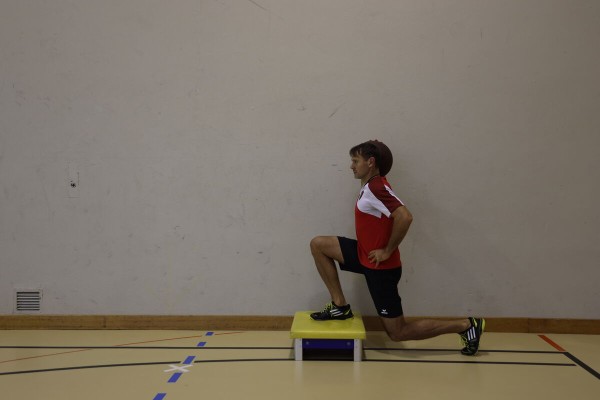
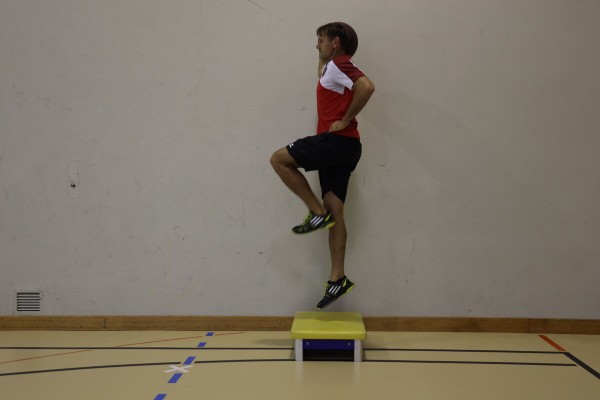
Stand in a lunge in front of the plyo box (the vaulting box - 1 intermediate element plus top), with the back (left) leg placed on the tip of the toe. A medicine ball (or another weight such as a dumbbell or kettlebell) is held on the side where the leg is placed on the raised base with the arm bent at the shoulder. Move the back leg onto the raised surface (leg bent at approximately a right angle), extend the free leg in a fluid movement and at the same time perform a small jump into the air. Land back on the plyo box/swinging box using only the leg with which the one-legged jump was performed. Then move the free leg back to the starting position in a lunge. The other (right) leg accompanies the movement (bend the leg during the jump), but is only lifted off the floor and put down again in the same position (do not place the foot on the raised surface).
Attention:
Keep your upper body upright, distribute your weight over your entire foot, push your knees outwards (do not tilt them inwards).
Lighten:
Select a lower element; do not jump; do not hold any weight on the shoulder.
Harden:
Select a higher element; more weight; additional weight on the foot.
Variation:
Hold a weight (dumbbell or kettlebell) in both hands with hanging arms.
1 plyo box/swinging box
1 medicine ball/dumbbell/kettlebell
1 weight sleeve/weight waistcoat ► make the exercise more difficult (additional weight)
1 additional dumbbell/kettlebell ► variation of the exercise
Step onto an object and one-legged jump (right) ► step up & hop
Power
Individual work

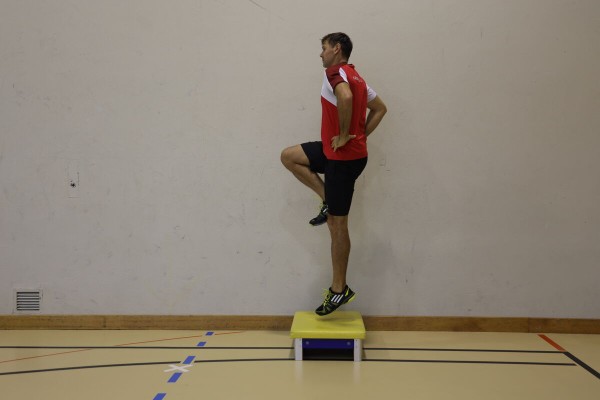
Stand in a lunge in front of the plyo box (the vaulting box - 1 intermediate element plus top), with the back (right) leg resting on the tip of the toe. Move the back leg onto the raised surface (leg bent at approximately a right angle), extend the free leg in a fluid movement and at the same time perform a small jump into the air. Land back on the plyo box/swinging box using only the leg with which the one-legged jump was performed. Then move the free leg back to the starting position in a lunge. The other (left) leg accompanies the movement (bend the leg during the jump), but is only lifted off the floor and put down again in the same position (do not place the foot on the raised surface).
Attention:
Keep the upper body upright, distribute the weight over the entire foot, push the knee outwards (do not tilt inwards).
Lighten:
Select a lower element; do not perform a jump.
Harden:
Select a higher element; add weight (on the shoulder, in the hands or on the foot).
1 plyo box/swivel box
1-2 dumbbells/kettlebells/weight man chains/1 weight vest/medicine ball ► make the exercise more difficult (additional weight)
Step onto an object and one-legged jump (right) ► step up & hop
Power
Individual work
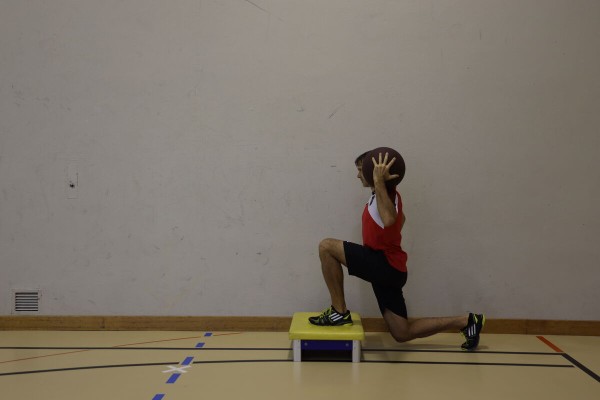
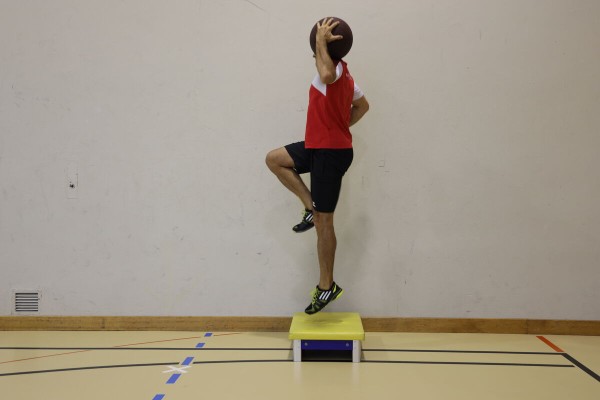
Stand in a lunge in front of the plyo box (the vaulting box - 1 intermediate element plus top), with the back (right) leg placed on the tip of the toe. A medicine ball (or another weight such as a dumbbell or kettlebell) is held on the side where the leg is placed on the raised base with the arm bent at the shoulder. Move the back leg onto the raised surface (leg bent at approximately a right angle), extend the free leg in a fluid movement and at the same time perform a small jump into the air. Land back on the plyo box/swinging box using only the leg with which the one-legged jump was performed. Then move the free leg back to the starting position in a lunge. The other (left) leg accompanies the movement (bend the leg during the jump), but is only lifted off the floor and put down again in the same position (do not place the foot on the raised surface).
Attention:
Keep the upper body upright, distribute the weight over the entire foot, push the knee outwards (do not tilt inwards).
Lighten:
Select a lower element; do not jump; do not hold any weight on the shoulder.
Harden:
Select a higher element; more weight; additional weight on the foot.
Variation:
Hold a weight (dumbbell or kettlebell) in both hands with hanging arms.
1 plyo box/swinging box
1 medicine ball/dumbbell/kettlebell
1 weight sleeve/weight waistcoat ► make the exercise more difficult (additional weight)
1 additional dumbbell/kettlebell ► variation of the exercise
Up and down movements in squat position (pulsating movement) ► squat pulse
Power
Individual work
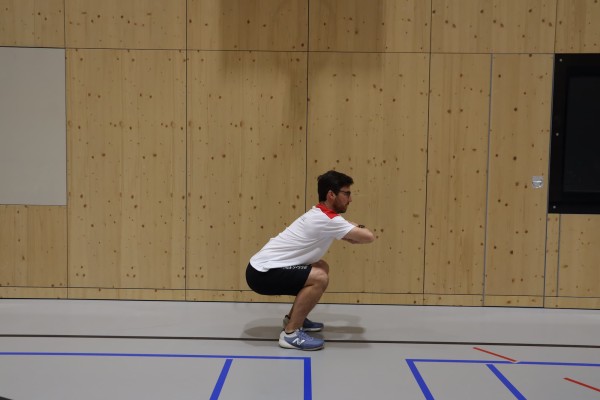
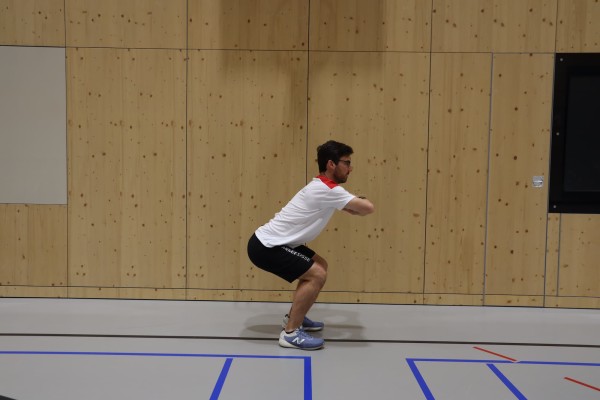
Deep squat position (ideally thighs parallel to the floor), feet hip to shoulder-width apart, knees pointing slightly outwards (10-30 degrees), corresponding to the tips of the feet, upper body upright, chest out, shoulders back down, abdominal muscles tensed. In this position, perform small pulsating up and down movements (approx. 5-10cm). The movements are controlled and rhythmic, without losing tension.
Attention:
Keep your back straight. Keep your knees stable (do not tilt them inwards). Keep your core tensed throughout the exercise.
Lighten:
Less deep squat position (the deeper, the more challenging).
Harden:
Additional weight (on your shoulders, in front of you or with hanging arms in your hands).
1 weight vest/(medicine) ball/weight disc/barbell/sandbag/2 dumbbells ► make the exercise more difficult (additional weight)
Bounce
Coordination exercises
Individual work
Take a running start parallel to the band, jump off over the front foot, touch down on the line with the back foot first, cushion the swing well with your knees and land in a cross-legged stance.
Variant
Jump without a running start with both feet at the same time.
Easier:
Jump onto a lower slackline.
Harder:
Jump onto a higher slackline; jump with a half turn.
1 Slackline
Lunge (left) ► split squat / split lunge
Power
Individual work

Stand upright, arms supported on the hips, lunge forward (with the left leg), bend the front (and back) leg to a right angle, hold the position.
Caution:
Always keep the front knee behind the tip of the foot and centred over the foot. Lower your body in the centre (follow the back knee like a plumb line, keep your upper body upright, tense your stomach).
Lighten:
Lower your upper body less (greater angle in the knees).
Harden:
Additional weight (on the shoulders, with hanging arms or in a forward or upright position); unstable base for supporting the front leg.
1 weight vest/weight disc/(medicine) ball/barbell/sandbag/fighting backpack/2 dumbbells ► Make the exercise more difficult (additional weight)
1 ball/balance cushion/balance board ► Make the exercise more difficult (unstable surface)
Lunge (left) ► split squat / split lunge
Power
Individual work


Lunge, upper body upright, front (left) leg on the balance board (board on the wedges) and bent to approximately a right angle, arms supported on the hips, crossed on the chest or behind the head or in front, hold the position.
Attention:
Upright upper body (tense torso), front knee always remains behind the tip of the foot and centred over the foot, distribute weight over the entire front foot.
Lighten:
Without a balance board; lower your upper body less (greater angle at the knees).
Harden:
Balance board on the roller (instead of on the wedges); additional weight (on the shoulders, with hanging arms or in a forward or upright position).
Variant:
Bend and straighten the front leg (raise and lower the upper body).
1 balance board
2 wedges (semicircular)
1 roller ► make the exercise easier
1 weight vest/weight disc/(medicine) ball/barbell/sandbag/2 dumbbells ► make the exercise more difficult (additional weight)
Lunge (left) ► split squat / split lunge
Power
Individual work


Start in a standing position on the balance board (lengthways on the board), with the leg resting flat on one end of the balance board (left) and the leg supported on the tips of the toes at the other end (right). Bend both legs so that the knee of the back leg (right) touches the balance board. Then stretch both legs back to the starting position.
Lighten:
Without the balance board; lower your upper body less (greater angle at the knees).
Harden:
Additional weight (on the shoulders, with hanging arms or in a forward or upright position).
1 balance board
1 weight vest/weight disc/(medicine) ball/sandbag/2 dumbbells ► make the exercise more difficult (additional weight)